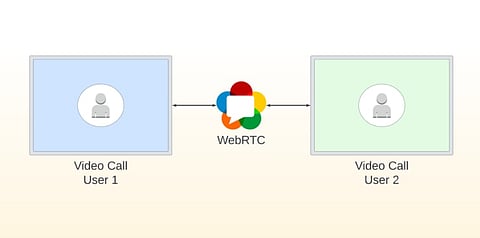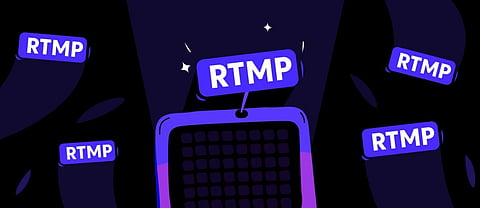Live streaming has taken a toll in the past few years, but various companies may lack proper protocols. To avoid finding yourself with a laggy, buffering, and low-quality video streaming, the two live streaming protocols to consider are WebRTC vs RTMP. These protocols specifically deal with different challenges evolving around performance, scalability, and latency. This article will explore all that and more, learning what to expect in 2026.
WebRTC Vs RTMP: Which Is Better For Live Streaming?
This article provides you with a breakdown of WebRTC vs RTMP, as it explores their purpose, capabilities, and user cases.
Part 1. Protocol Basics - Legacy vs Real-Time
Before we explore RTMP vs WebRTC, let's know the fundamentals behind each protocol:
1. What is WebRTC?
Web Real-Time Communication is a powerful open-source technology enabling direct, plugin-free audio and data streaming in modern browsers and apps. It uses Secure RTP (SRTP) for fast, encrypted connections and supports NAT traversal through ICE, STUN, and TURN.
WebRTC relies on APIs like getUserMedia to enable real-time interaction with latency often under 500 milliseconds. It works best for one-to-one or small group communication and also scales with servers like SFUs.

2. What is RTMP
On the contrary, real-time messaging protocol is a TCP-based streaming protocol originally built for Adobe Flash. While Flash is now obsolete, RTMP remains widely used as a first-mile ingest method, sending live feeds from encoders to media servers like Wowza or Red5.
In addition, it relies on a persistent TCP connection (usually over port 1935), offering reliable packet delivery but with slightly lower latency around 2-5 seconds.

3. RTMP vs WebRTC: Which Powers the Future of Live Video?
Now that you know the fundamentals of both protocols, let’s compare WebRTC vs RTMP directly to understand which one is better suited for modern live video channels:
Aspect | RTMP (Real-Time Messaging Protocol) | WebRTC (Web Real-Time Communication) |
Core Technology | TCP-based streaming protocols were initially designed for Adobe Flash. It is now used mainly for ingesting into media servers. | Open-source UDP-first protocol designed for live browser-to-browser audio/video/data streaming. |
Transport and Security | Uses a persistent TCP connection (port 1935) with variants like RTMPS supporting TLS/ SSL | Encrypted by default with DTLS/SRTCP using ICE/STUN/TURN for NAT traversal |
Architecture | Client-to-server: encoder → RTMP server → transcoded to HLS/DAS for viewers | Peer to Peer or SFUD-based for small groups; APIs: getUserMedia RTCPeerConnection RTCDataChannel |
Latency | 2 to 5 seconds faster than HLS/DASH but not real-time | Sub-500ms (often 50 to 500ms) ideal for real-time apps like gaming or live chat |
Scalability | Well-suited for large audiences when combined with CDNs; not for peer-to-peer | Optimized for small groups; scales via SFUs or MCUs but is more complex |
Compatibility | Supported by most encoders (OBS Wirecast) but not by browsers native; requires HTTP playback formats | Natively supported in modern browsers (Chrome Firefox etc.) |
Adaptive Bitrate | Fixed bitrate stream | Dynamical bitrate/ resolution adaptation based |
Part 2. Understanding Use Cases - When WebRTC or RTMP Works Best
Getting a better grasp of the two protocols, now learn about the various user cases these video streaming protocols have to offer in the following:
1. Build-in Encryption
WebRTC is a secure protocol by default and has a mandatory encryption of DTLS/SRTP, which secures your live video conferencing from any intruders. Whereas RTMP offers basic encryption, its security is added via RTMPS (RTMP over TLS/SSL).
Even if the encryption is basic, its security also requires additional configuration to be used. Therefore, with WebRTC’s sub-second latency, browser-native, secure real-time interaction, it is better.

2. Ultra Low-Latency
Another win for WebRTC in the WebRTC vs RTMP battle is its ultra-low-latency rate, providing up to 500 milliseconds. Having this protocol, during a video call or gaming session, ZEGOCLOUD WebRTC solution offers the ideal WebRTC for seamless engagement and receiving fast feedback.
As for RTMP, it gets delayed by 2 to 5 seconds, which is sufficient when you are broadcasting shows. In instances where a short delay is allowed, turn to the RTMP protocol.
3. Scalability
If you want to deliver a speech to a massive crowd or millions of users over a live stream, RTMP is used by hybrid architectures. They use it for reliable ingestion and automatic transcoding of HLS/DASH for scalable distribution.
In comparison to WebRTC, it is designed for smaller audiences, ranging from 50 to 1000. Therefore, utilize the RTMP live streaming protocol to reach millions of viewers using CDN distribution.

4. Compatibility
In terms of compatibility, the two protocols, RTMP vs WebRTC, reveal that WebRTC supports all modern browsers and mobile devices. Moreover, the RTMP is usually used for encoder ingestion, but it doesn’t support most of the browsers, like Chrome, Safari, and more.
For users who want to video chat and arrange a conference, WebRTC is excellent for such applications. Therefore, if you’re looking for a strong encoder, WebRTC is for you.
5. API Assistance
You will find open-source libraries or existing software solutions like OBS and Wirecast for RTMP. Besides, platforms such as the ZEGOCLOUD WebRTC SDK provide ready-to-use APIs for building custom real-time communication features. This makes it easier to conduct hybrid streaming sessions, seminars, and other interactive events. Overall, WebRTC offers more flexibility than RTMP across multiple use cases.
Part 3. Viewer Expectations in 2026: What Users Expect from WebRTC and RTMP
In the upcoming years, WebRTC is expected to stand out in the WebRTC vs RTMP debate because it offers strong real-time features and responsive live-streaming performance. With its low latency for gaming, auctions, and interactive sessions, it is often the ideal choice. RTMP still remains useful, offering scalability, reliable ingestion, and a solid broadcasting workflow. Large companies can benefit from tools like ZEGOCLOUD live streaming solution that support both WebRTC and RTMP workflows.
Conclusion
To conclude this article, users learned about the complexity of WebRTC vs RTMP and which reigns supreme against the other. Both live streaming protocols excel in their own ability to handle video conferencing, gaming sessions, and more. Therefore, this article looked into a detailed comparison table and explanation of the two concepts, and topped it off with multiple user cases.
Disclaimer : This is a sponsored article. All possible measures have been taken to ensure accuracy, reliability, timeliness and authenticity of the information; however Outlookindia.com does not take any liability for the same. Using of any information provided in the article is solely at the viewers’ discretion.